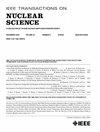Design, Fabrication, and Cold Test of a High-Efficiency C-Band Traveling-Wave Accelerating Structure
IF 1.9
3区 工程技术
Q3 ENGINEERING, ELECTRICAL & ELECTRONIC
引用次数: 0
Abstract
To implement the linear injector for the proposed Jinhua light source (JHLS) project, a 1-m C-band constant gradient (CG) traveling-wave (TW) accelerating structure is developed with the aim of generating a gradient of高效c波段行波加速结构的设计、制造与冷态试验
为了实现提出的金华光源(JHLS)项目的线性注入器,开发了1 m c波段恒定梯度(CG)行波(TW)加速结构,目的是产生$\geq 40$ MV/m的梯度。这种c波段结构工作在$3\pi $ /4模式下,以相对较低的群速度从$0.016c$到$0.009c$变化,以增加给定输入功率下的加速梯度。它采用椭圆虹膜和圆弧顶的电池形状,通过优化减少了表面电场和磁场,平均分流阻抗为94 M $\Omega $ / M。在29.6 MW的输入功率下产生40 MV/m的加速梯度,这意味着该结构可以高效地将输入功率转化为加速梯度。此外,采用了一种新的设计方法,大大简化了整个优化过程,实现了较高的精度。在制作完成后,对结构进行了精确调谐,并给出了低功率射频(RF)测量结果以及与仿真值的比较。
本文章由计算机程序翻译,如有差异,请以英文原文为准。
求助全文
约1分钟内获得全文
求助全文
来源期刊

IEEE Transactions on Nuclear Science
工程技术-工程:电子与电气
CiteScore
3.70
自引率
27.80%
发文量
314
审稿时长
6.2 months
期刊介绍:
The IEEE Transactions on Nuclear Science is a publication of the IEEE Nuclear and Plasma Sciences Society. It is viewed as the primary source of technical information in many of the areas it covers. As judged by JCR impact factor, TNS consistently ranks in the top five journals in the category of Nuclear Science & Technology. It has one of the higher immediacy indices, indicating that the information it publishes is viewed as timely, and has a relatively long citation half-life, indicating that the published information also is viewed as valuable for a number of years.
The IEEE Transactions on Nuclear Science is published bimonthly. Its scope includes all aspects of the theory and application of nuclear science and engineering. It focuses on instrumentation for the detection and measurement of ionizing radiation; particle accelerators and their controls; nuclear medicine and its application; effects of radiation on materials, components, and systems; reactor instrumentation and controls; and measurement of radiation in space.
 求助内容:
求助内容: 应助结果提醒方式:
应助结果提醒方式:


